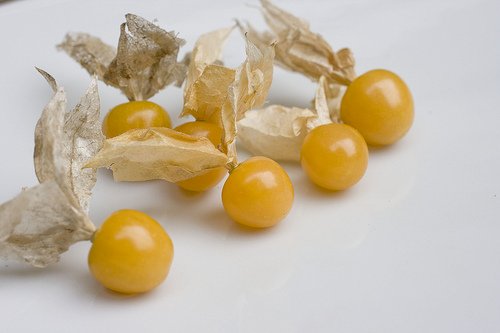tillo-berry pie
 Tuesday, September 11, 2012 at 4:00AM |
Tuesday, September 11, 2012 at 4:00AM |  Seeley deBorn
Seeley deBorn They really are fruits.
If you've ever seen a cape gooseberry, you'll know where I'm going with this. They're also sometimes called 'husk cherries'. I was served one once as a garnish on a fancy dessert, and had no clue what it was, so I didn't eat it. I really should have.

Because then I'd be able to tell you how they taste compared to a tomatillo.
Yup, a tomatillo. Very closely related to the cape gooseberry, in look and in taste.
Like tomatoes, tomatillos seem to have been relegated to the realm of savoury foods. They don't have to be though. They really are kinda sweet. They've got a bit of a citrus flavour to them too. And they pair nicely with cinnamon when you put them in a pie. It comes out as kinda 'mock apple' which is good I think, because it kinda eases people into the idea that you can actually eat this thing in a sweet dish.
The trend lately with foods seems to be the addition of sweet things to savoury ones, so Recipe Guy and I (being contrary, as usual) decided that we'd take something typically savoury and make it sweet.
Tillo-Berry Pie
- about 1 pound of small tomatillos
- 3/4 c sugar
- 3 tbsp tapioca
- 1 tsp lemon zest
- 1/2 tsp cinnamon
- 1/4 tsp nutmeg
- double pice crust
If you want to make your own crust, you'll need
- 2/3 c cold butter
- 2 1/2 c flour
- 1/2 tsp salt
- 6-8 tbsp cold water
I like making my own crust, and it's really quite easy. Unlike making cakes and muffins, you want all of your pie crust ingredients nice and chilly.
Cut the cold butter into chunks about a tbsp in size, and dump in the flour and salt.
Use a pastry cutter to cut it all together until the biggest chunks of butter are about the size of peas.
Sprinkle on about 5 tbsp of ice water, and use a fork to cut the water into the flour. You don't want to "mix" this.
Mixing causes gluten to form and stretch, which is great for cakes and bread, but really the opposide of what you want for a flaky tender pastry.
Dump the very crumbly mixture out onto your rolling surface and add another tbsp or two of water.
The way I deal with pastry now is patting and folding. Pat-a-cake, pat-a-cake baker's me! Resist the urge to do anything remotely related to kneading.
At first, the folding will be a bit weird, and not much like folding. You'll just be picking up part of the dough and putting it on top of another part, and then pressing them together. If it doesn't hold well after a couple times of doing this, sprinkle on a bit of water, and then fold a few more times.
Eventually, you'll end up with a lump that mostly sticks together after you pat it.
Cut this lump in half, set the slightly smaller half aside, and flour the other one, your surface, and your rolling pin. Check as you roll to make sure that it's not sticking.
If it is, use a knife to gently separate it from your surface, and flour both the surface and the pastry.
Roll it until it's a good couple inches in diameter bigger than your pie plate.
Use your rolling pin to help you carry it to the pie plate.
The filling is pretty simple.
Peel the pretty little paper lanterns off your tomatillos, and rinse them off.
Recipe Guy seems to have one plant that makes slightly purple tomatillos. Apparently there are varieties that are entirley purple.
Slice the tillos. Put them in a bowl.
Dump the other stuff on top.
Stir. Dump the filling into the crust.
Easy as...
The other half of your pie crust needs to be rolled out now. You can make a circle and put it on top whole (cut slits in it for steam to escape), or you can do a lattice top. A lot easier than you think and makes people say "ooo".
Roll out your other half into a rectangle, and slice it into 7 strips.
Lay 3 strips on the pie, and then fold the middle one back, and lay one of the remaining 4 across the two strips.
Switch! One comes forward, two go back.
Repeat until you run out of strips.
Press the edges of the strips to the edge of the bottom crust, and use the scraps left after cutting your strips to fill in the blank spots.
I recommend brushing the crust with a beaten egg now, rather than after it's been in the oven for 20 minutes. The egg makes is lovely and shiney, and helps its brown a bit too.
Bake at 425 for 20 minutes, then turn down the heat to 350, and bake for another 30 minutes.
The early high heat helps the crust brown and crisp before the fruit starts oozing juices all over it and making it soggy. The later lower heat makes those juices bubble into tasty sweet filling.
It worked! It really worked!
I think I'd like to put a few more tomatillos in next time, and maybe less cinnamon to make it less like a mock apple and more like a tillo pie, but it really did work!
What "savoury" ingredient do you think would work well in a sweet?
